Intelligent Demand Side Management for Exhaustive Techno-Economic Analysis of Microgrid System
Abstract
1. Introduction
1.1. Related Work
1.2. Motivation and Contribution
1.3. Arrangement of the Proposed Paper
2. Mathematics of Fitness Function and its Formulation
2.1. Strategy Incorporated in DSM
2.2. Procedure to Attain a Restructured Load Model by Means of DSM Approach
2.3. Differential Evolution Algorithm
3. Descriptive Techno-Economic Analysis of a Subject Test System
3.1. Description of the Subject Test System and Simulation Environment
3.1.1. Stage 1: Effects of DSM Implementation
3.1.2. Stage 2: Exhaustive Techno-Economic Analysis
| Case 1 | Without DERs: it is assumed that the grid supplies the entire load demand of the MG system and there is no DER, neither RES nor fossil-fueled DERs are present. In that case, the generation cost of the MG system per day was $23,203 for forecasted load demand, which reduced gradually to $22,095 when DSM participation was increased up to 40%. |
| Case 2 | Ideal Case: As hinted by the name of the scenario, this is the ideal case of MG operation, meaning all the DERs are actively participating to share the load demands every hour. In this case, the grid buys and sells power to and from the MG at the same price (denoted by CP in Figure 6). The generation cost in this case was found to be $8326, which is a 64% reduction from the previous case. This signifies the benefits of an MG system where DERs share the load demand, instead of being solely dependent on the grid. Moreover, the generation cost dropped to $7311 when the restructured load demand with 40% DSM participation level was considered. Figure 8 displays the load sharing model of the DERs for this case when generation cost was minimized to $7311. The grid actively buying and selling power can be clearly seen from Figure 6. Since this is considered to be the ideal case, the rest of the cases shall be compared with this. |
| Case 3 | Without RES: The contribution of the WT was not considered in this scenario. The total output of the WT as shown in Figure 5 was 5525 kW, which is 7% of the total load demand of the MG system. The generation cost in this case was found to be $9857, which is an approximate 18% increase over the ideal case. |
| Case 4 | Passive Grid: In this case, the participation of the grid is demand-centric. This means that the grid will only supply power if the load demand is not being met by the rest of the DERs. For the rest of the time, the grid will be in stand-by mode. Mathematically, this scenario can be achieved by fixing the lower limit of the grid to zero. Since the grid is not actively participating in buying and selling the power, it is quite obvious that the generation cost in this case ($8571) will be more than the ideal case ($8326). Figure 9 shows the hourly output of DERs when the generation cost was minimized for Case 4 with 40% DSM. It can be seen that the grid is supplying power from hours 1 through 7 and 23. There is no negative value of the grid in the figure, unlike Figure 8. |
| Case 5 & Case 6 | Taxable SP: The grid buys and sells power with different amounts and the same was mathematically modelled in (3) and (4) above. The tax was 20% for Case 5 and 50% for Case 6. The generation cost with 20% tax was found to be $8475 and with 50% tax was found to be $8562. In either of the cases, the generation cost was found to be more than the ideal case both with and without DSM. |
| Case 7 | Different SP/CP: The electricity market price in this case is followed as shown in Figure 6. Here, the generation cost is more than the ideal case too. |
| Overall observation |
|
4. Conclusions
- The generation cost is minimized when the grid actively buys and sells power to and from the MG system. Passive participation of the grid may act as back-up to supply deficit power but have no role in decreasing the MG cost.
- TOU-based electricity market pricing strategy where the grid buys and sells power with the same price incurs the least generation cost compared to any other electricity market pricing strategies.
- DSM plays a significant role in minimizing the generation cost of the MG system. Additionally, it also improves the load factor of the system and reduces the peak demand, as observed by the results obtained.
5. Future Works
Author Contributions
Funding
Data Availability Statement
Conflicts of Interest
References
- Ghosh, B.; Dey, B.; Bhattacharya, A. Solving economic load dispatch problem using hybrid Krill Herd algorithm. In Proceedings of the 2015 International Conference on Energy, Power and Environment: Towards Sustainable Growth (ICEPE), Shillong, India, 12–13 June 2015. [Google Scholar]
- Yalcinoz, T.; Short, M.J. Neural networks approach for solving economic dispatch problem with transmission capacity constraints. IEEE Tran. on Pow. Sys. 1998, 13, 307–313. [Google Scholar] [CrossRef]
- Dhillon, J.; Parti, S.C.; Kothari, D.P. Stochastic economic emission load dispatch. Elect. Pow. Sys. Res. 1993, 26, 179–186. [Google Scholar] [CrossRef]
- Wang, C.; Shahidehpour, S.M. Ramp-rate limits in unit commitment and economic dispatch incorporating rotor fatigue effect. IEEE Tran. on Pow. Sys 1994, 9, 1539–1545. [Google Scholar] [CrossRef]
- Kai, S.; Qing, L.; Jizhen, L.; Yuguang, N.; Ruifeng, S.; Yang, B. New combination strategy of genetic and tabu algorithm an economic load dispatching case study. In Proceedings of the 2011 Chinese Control and Decision Conference (CCDC), Mianyang, China, 23–25 May 2011. [Google Scholar]
- Bhattacharya, A.; Chattopadhyay, P.K. Solving complex economic load dispatch problems using biogeography-based optimization. Exp. Sys. with App. 2010, 37, 3605–3615. [Google Scholar] [CrossRef]
- Sinha, N.; Chakrabarti, R.; Chattopadhyay, P.K. Evolutionary programming techniques for economic load dispatch. IEEE Trans. Evol. Comp. 2003, 7, 83–94. [Google Scholar] [CrossRef]
- Daniel, L.; Chaturvedi, K.T.; Kolhe, M.L. Dynamic Economic Load Dispatch using Levenberg Marquardt Algorithm. Energy Procedia 2018, 144, 95–103. [Google Scholar] [CrossRef]
- Hosseinnezhad, V.; Babaei, E. Economic load dispatch using θ-PSO. Int. J. Electr. Pow. Energy Syst. 2013, 49, 160–169. [Google Scholar] [CrossRef]
- Yang, X.; Leng, Z.; Xu, S.; Yang, C.; Yang, L.; Liu, K.; Zhang, L. Multi-objective optimal scheduling for CCHP microgrids considering peak-load reduction by augmented ε-constraint method. Renew. Energy 2021, 172, 408–423. [Google Scholar] [CrossRef]
- Nwulu, N.I.; Xia, X. Optimal dispatch for a microgrid incorporating renewables and demand response. Renew. Energy 2017, 101, 16–28. [Google Scholar] [CrossRef]
- Coelho, V.N.; Coelho, I.M.; Coelho, B.N.; Cohen, M.W.; Reis, A.J.; Silva, S.M.; Souza, M.J.; Fleming, P.J.; Guimarães, F.G. Multi-objective energy storage power dispatching using plug-in vehicles in a smart-microgrid. Renew. Energy 2016, 89, 730–742. [Google Scholar] [CrossRef]
- Grefenstette, J.J. Genetic algorithms and machine learning. In Proceedings of the Sixth Annual Conference on Computational Learning Theory, Santa Cruz, CA, USA, 26–28 July 1993. [Google Scholar]
- Dutta, S.; Reddy, M.J.B.; Mohanta, D.K.; Kushwah, M.S.; Sadhu, P.K. μPMU-based intelligent island detection–the first crucial step toward enhancing grid resilience with MG. IET Sma. Gri. 2020, 3, 162–173. [Google Scholar] [CrossRef]
- Chen, C.; Duan, S.; Cai, T.; Liu, B.; Hu, G. Smart energy management system for optimal microgrid economic operation. IET Renew. Power Gener. 2011, 5, 258–267. [Google Scholar] [CrossRef]
- Kasaei, M.J. Energy and operational management of virtual power plant using imperialist competitive algorithm. Int. Trans. Electr. Energy Syst. 2018, 28, e2617. [Google Scholar] [CrossRef]
- Basu, M.A.; Chowdhury, A. Cuckoo search algorithm for economic dispatch. Energy 2013, 60, 99–108. [Google Scholar] [CrossRef]
- Moghaddam, A.A.; Seifi, A.; Niknam, T.; Pahlavani, M.R.A. Multi-objective operation management of a renewable MG (micro-grid) with back-up micro-turbine/fuel cell/battery hybrid power source. Energy 2011, 36, 6490–6507. [Google Scholar] [CrossRef]
- Rabiee, A.; Sadeghi, M.; Aghaei, J. Modified imperialist competitive algorithm for environmental constrained energy management of microgrids. J. Clean. Prod. 2018, 202, 273–292. [Google Scholar] [CrossRef]
- Trivedi, I.N.; Jangir, P.; Bhoye, M.; Jangir, N. An economic load dispatch and multiple environmental dispatch problem so-lution with microgrids using interior search algorithm. Neur. Comp. App. 2018, 30, 2173–2189. [Google Scholar] [CrossRef]
- Elattar, E.E. Modified harmony search algorithm for combined economic emission dispatch of microgrid incorporating renewable sources. Energy 2018, 159, 496–507. [Google Scholar] [CrossRef]
- Faseela, C.K.; Vennila, H. Economic and emission dispatch using Whale Optimization Algorithm (WOA). Int. J. Electr. Comput. Eng. 2018, 8, 1297. [Google Scholar] [CrossRef]
- Kumar, K.P.; Saravanan, B.; Swarup, K.S. Optimization of Renewable Energy Sources in a Microgrid Using Artificial Fish Swarm Algorithm. Energy Procedia 2016, 90, 107–113. [Google Scholar] [CrossRef]
- Gholami, K.; Dehnavi, E. A modified particle swarm optimization algorithm for scheduling renewable generation in a mi-cro-grid under load uncertainty. Appl. Soft Comp. 2019, 78, 496–514. [Google Scholar] [CrossRef]
- Askarzadeh, A. A Memory-Based Genetic Algorithm for Optimization of Power Generation in a Microgrid. IEEE Trans. Sustain. Energy 2017, 9, 1081–1089. [Google Scholar] [CrossRef]
- Ramli, M.A.; Bouchekara, H.R.E.H.; Alghamdi, A.S. Efficient Energy Management in a Microgrid with Intermittent Renewable Energy and Storage Sources. Sustainability 2019, 11, 3839. [Google Scholar] [CrossRef]
- Maulik, A.; Das, D. Optimal operation of microgrid using four different optimization techniques. Sustain. Energy Technol. Assessments 2017, 21, 100–120. [Google Scholar] [CrossRef]
- Nayak, A.; Maulik, A.; Das, D. An integrated optimal operating strategy for a grid-connected AC microgrid under load and renewable generation uncertainty considering demand response. Sustain. Energy Technol. Assess. 2021, 45, 101169. [Google Scholar] [CrossRef]
- Harsh, P.; Das, D. Energy management in microgrid using incentive-based demand response and reconfigured network considering uncertainties in renewable energy sources. Sustain. Energy Technol. Assess. 2021, 46, 101225. [Google Scholar] [CrossRef]
- Tah, A.; Das, D. Operation of small hybrid autonomous power generation system in isolated, interconnected and grid connected modes. Sustain. Energy Technol. Assess. 2016, 17, 11–25. [Google Scholar] [CrossRef]
- Younes, Z.; Alhamrouni, I.; Mekhilef, S.; Reyasudin, M. A memory-based gravitational search algorithm for solving economic dispatch problem in micro-grid. Ain Shams Eng. J. 2021, 12, 1985–1994. [Google Scholar] [CrossRef]
- Mirjalili, S.; Mirjalili, S.M.; Lewis, A. Grey wolf optimizer. Adv. Eng. Soft. 2014, 69, 46–61. [Google Scholar] [CrossRef]
- Khandelwal, A.; Bhargava, A.; Sharma, A.; Sharma, H. Modified Grey Wolf Optimization Algorithm for Transmission Network Expansion Planning Problem. Arab. J. Sci. Eng. 2018, 43, 2899–2908. [Google Scholar] [CrossRef]
- Mirjalili, S. SCA: A Sine Cosine Algorithm for solving optimization problems. Knowl. Based Syst. 2016, 96, 120–133. [Google Scholar] [CrossRef]
- Askarzadeh, A. A novel metaheuristic method for solving constrained engineering optimization problems: Crow search algorithm. Comput. Struct. 2016, 169, 1–12. [Google Scholar] [CrossRef]
- Das, S.; Suganthan, P.N. Problem Definitions and Evaluation Criteria for CEC 2011 Competition on Testing Evolutionary Algorithms on Real World Optimization Problems; Jadavpur University, Nanyang Technological University: Kolkata, India, 2010. [Google Scholar]
- Rizk-Allah, R.M.; Hassanien, A.E.; Bhattacharyya, S. Chaotic crow search algorithm for fractional optimization problems. Appl. Soft Comput. 2018, 71, 1161–1175. [Google Scholar] [CrossRef]
- Kumar, K.P.; Saravanan, B. Day ahead scheduling of generation and storage in a microgrid considering demand Side man-agement. J. Energy Storage 2019, 21, 78–86. [Google Scholar] [CrossRef]
- Sharma, S.; Bhattacharjee, S.; Bhattacharya, A. Operation cost minimization of a Micro-Grid using Quasi-Oppositional Swine Influenza Model Based Optimization with Quarantine. Ain Shams Eng. J. 2018, 9, 45–63. [Google Scholar] [CrossRef]
- Sharma, S.; Bhattacharjee, S.; Bhattacharya, A. Grey wolf optimisation for optimal sizing of battery energy storage device to minimise operation cost of microgrid. IET Gener. Transm. Distrib. 2016, 10, 625–637. [Google Scholar] [CrossRef]
- Wei, J.; Zhang, Y.; Wang, J.; Wu, L.; Zhao, P.; Jiang, Z. Decentralized Demand Management Based on Alternating Direction Method of Multipliers Algorithm for Industrial Park with CHP Units and Thermal Storage. J. Mod. Power Syst. Clean Energy 2022, 10, 120–130. [Google Scholar] [CrossRef]
- Dey, B.; Raj, S.; Mahapatra, S.; Márquez, F.P.G. Optimal scheduling of distributed energy resources in microgrid systems based on electricity market pricing strategies by a novel hybrid optimization technique. Int. J. Electr. Power Energy Syst. 2021, 134, 107419. [Google Scholar] [CrossRef]
- Dey, B.; Bhattacharyya, B.; Devarapalli, R. A novel hybrid algorithm for solving emerging electricity market pricing problem of microgrid. Int. J. Intell. Syst. 2021, 36, 919–961. [Google Scholar] [CrossRef]
- Lokeshgupta, B.; Sivasubramani, S. Multi-objective harmony search algorithm for dynamic optimal power flow with demand side management. Electr. Power Comp. Syst. 2019, 47, 692–702. [Google Scholar]
- Lokeshgupta, B.; Sivasubramani, S. Multi-objective dynamic economic and emission dispatch with demand side management. Int. J. Electr. Power Energy Syst. 2018, 97, 334–343. [Google Scholar] [CrossRef]
- Datta, J.; Das, D. Stochastic Energy Management of grid-connected microgrid considering battery degradation cost and re-newables penetration. In Proceedings of the 2020 IEEE International Conference on Power Systems Technology, Bangalore, India, 14–16 September 2020. [Google Scholar]

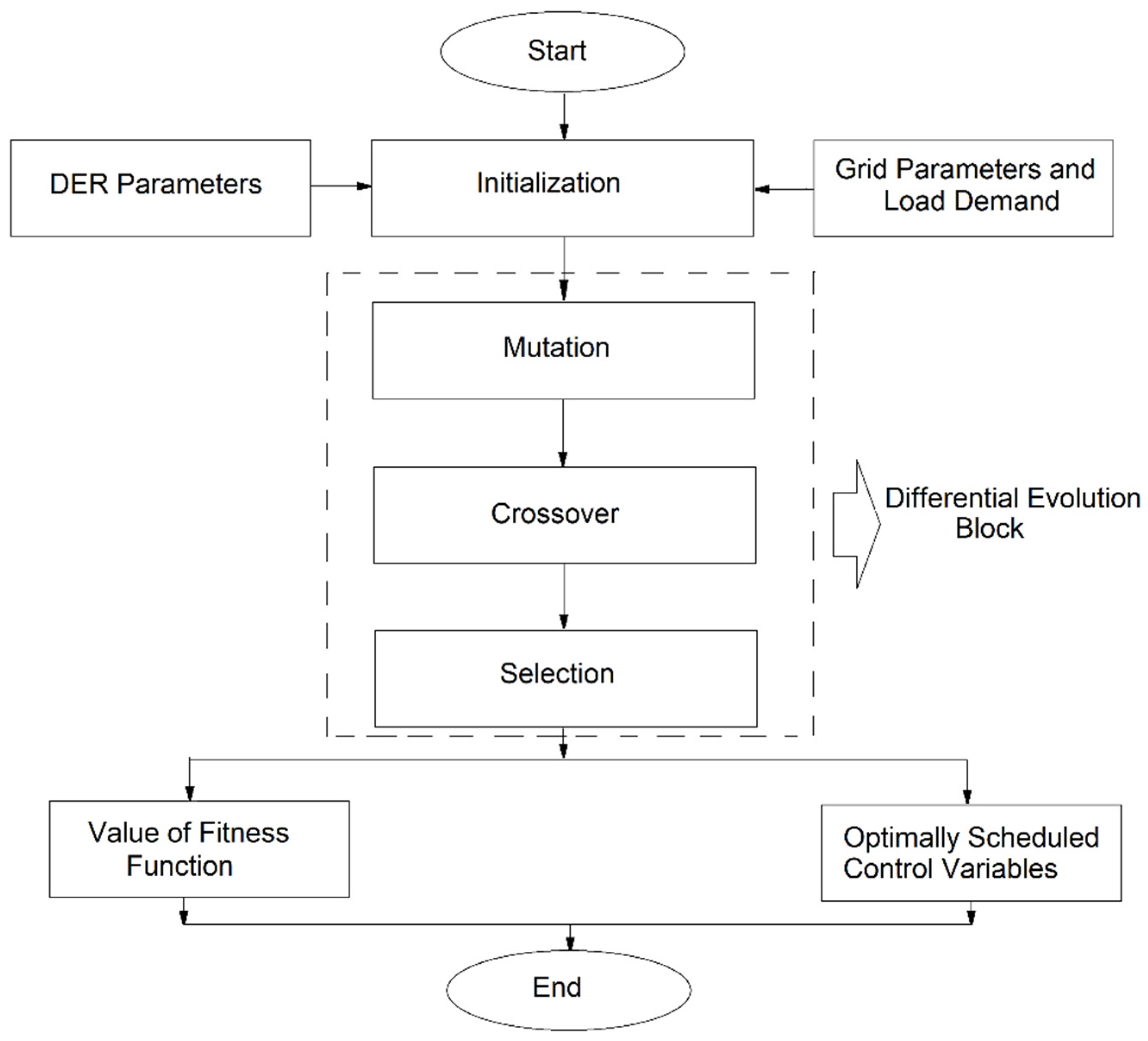


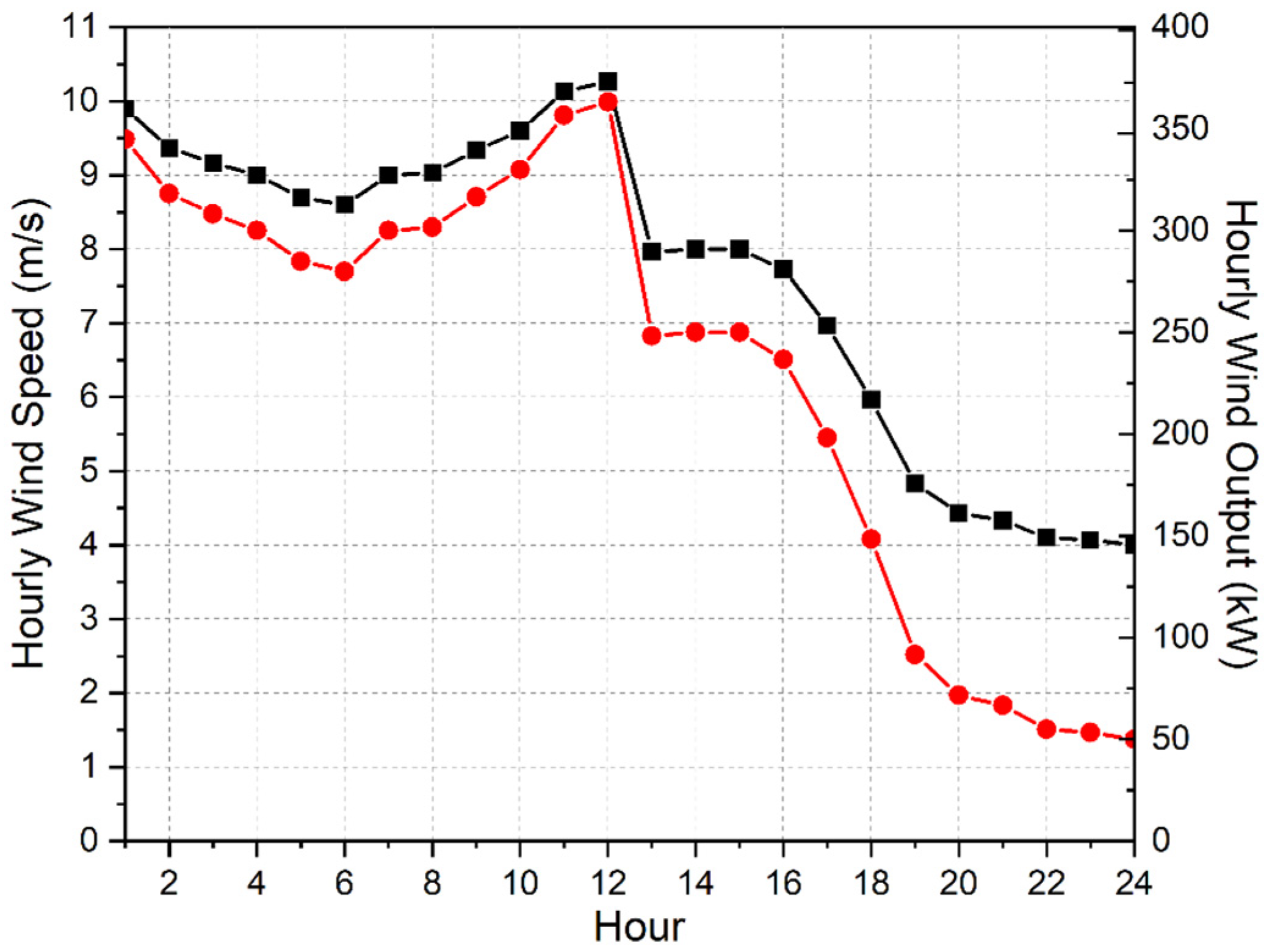

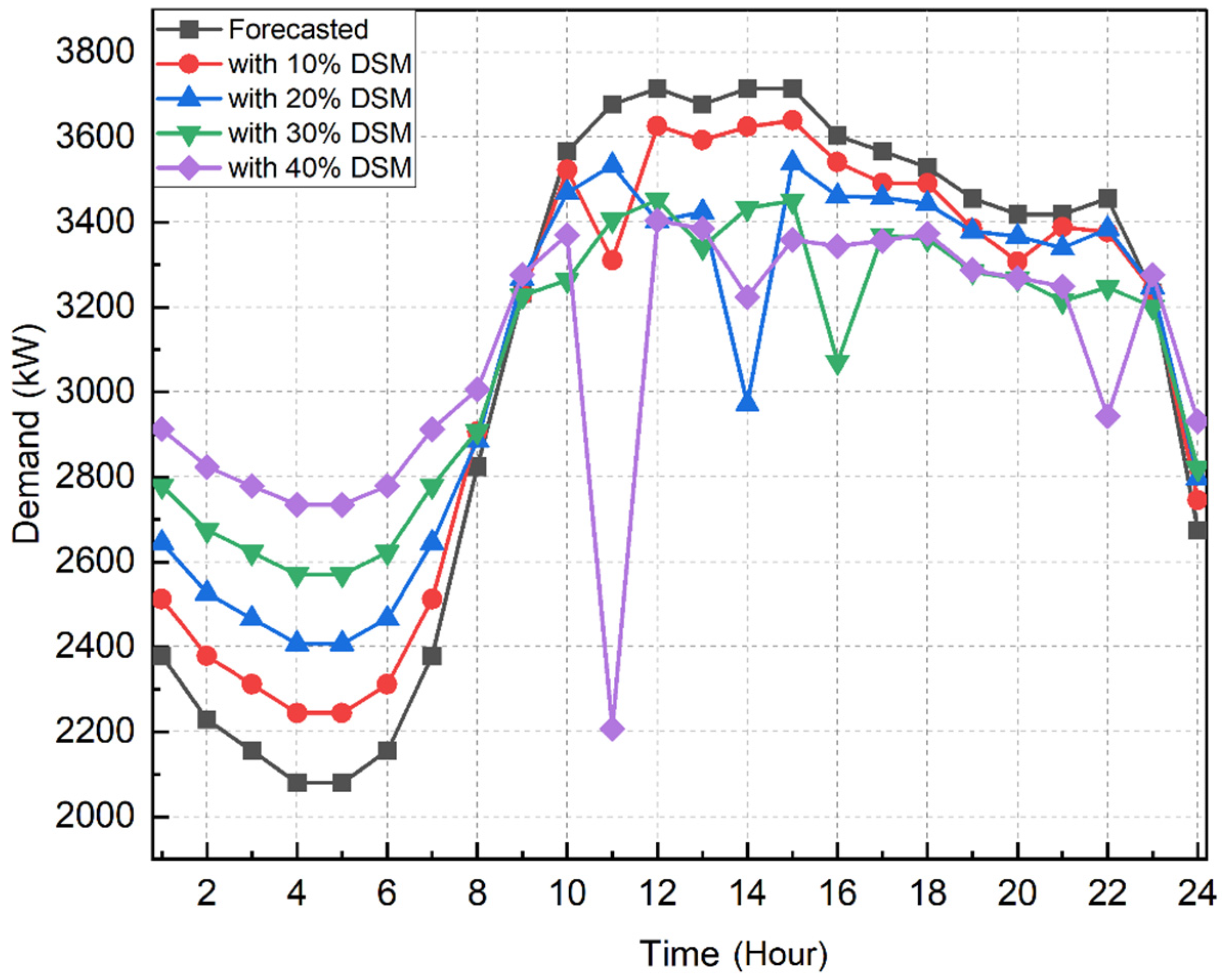


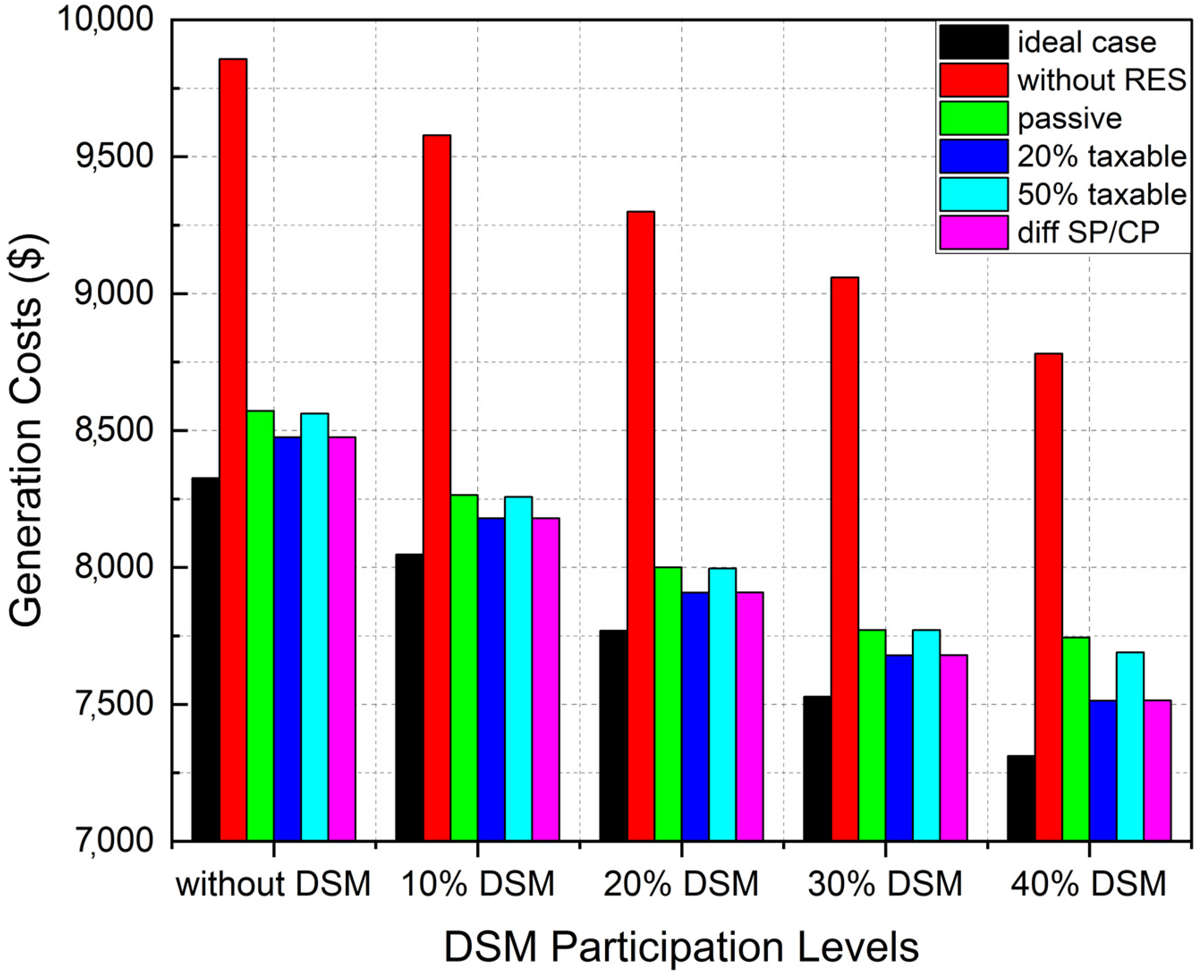
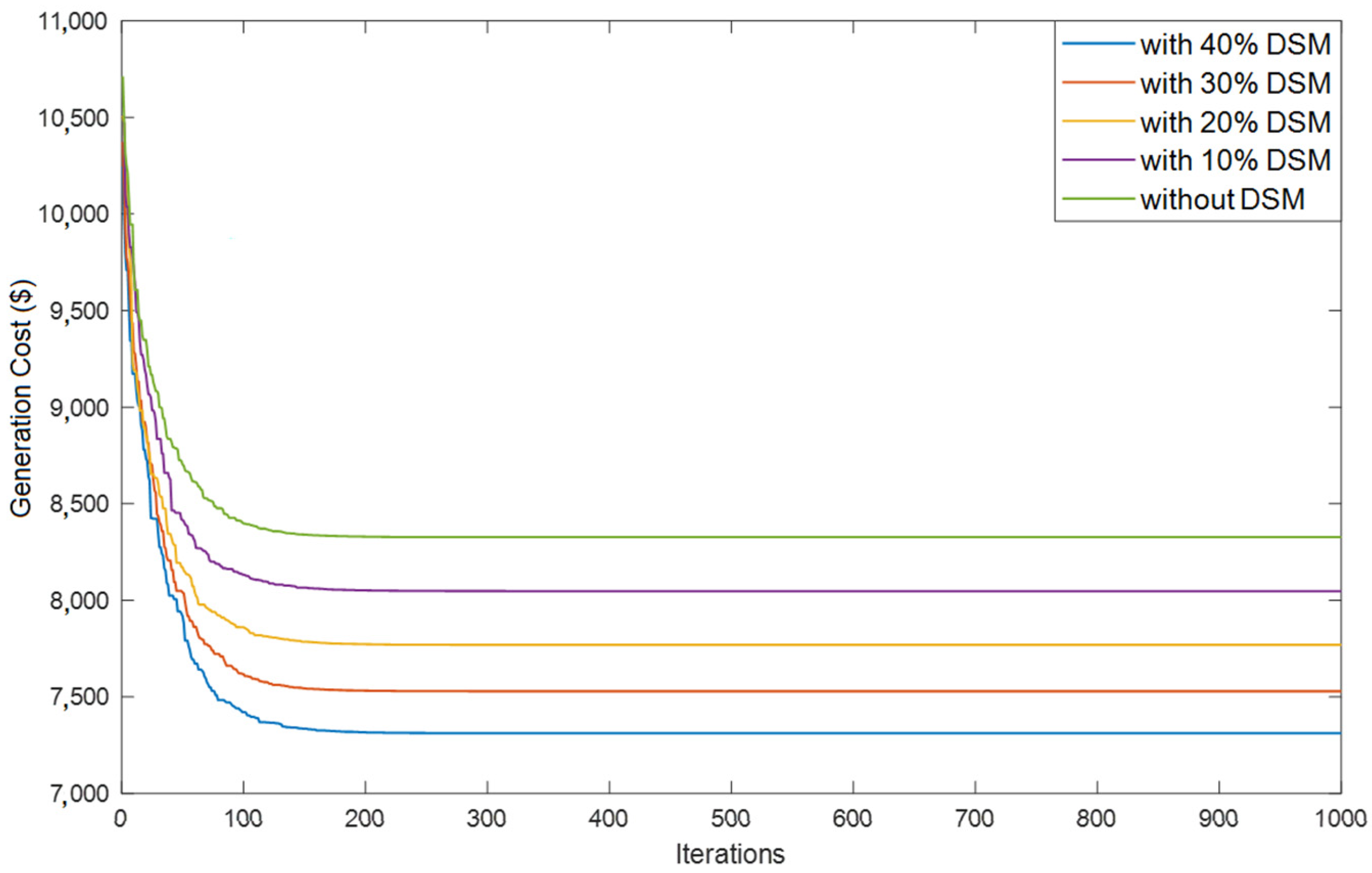
| Distributed Generation Units | Micro Turbine | Combined Heat and Power | Natural Gas Fuel Cell | Biomass | Grid |
|---|---|---|---|---|---|
| Pmin (kW) | 100 | 100 | 100 | 100 | −800 |
| Pmax (kW) | 600 | 800 | 800 | 1000 | 800 |
| Fuel Cost ($/kWh) | 0.021 | 0.027 | 0.027 | 0.063 | Figure 6 |
| Operational and Maintenance Cost ($/kWh) | 0.00587 | 0.00419 | 0.00419 | 0.01258 | NA |
| Efficiency | 0.3 | 0.35 | 0.35 | 0.29 | NA |
| Emission (kg/kWh) | 0.724 | 0.408 | 0.336 | 0.003 | 0.547 |
| Case | Brief Nomenclature | Detailed Description |
|---|---|---|
| 1 | Without DER | Only grid will supply power and fulfill demand of the MG |
| 2 | Ideal Case | All the DERs and grid will participate actively to share demand. Grid will buy and sell electricity with the same price. |
| 3 | Without RES | Same as scenario 2 excluding the contribution wind system |
| 4 | Passive Grid | Grid acts as back up to supply (sell) power only [42]. |
| 5 | 20% taxable price | Cost function of grid follows (3) and (4); tax = 20% [42,46] |
| 6 | 50% taxable price | Cost function of grid follows (3) and (4); tax = 50% [42,46] |
| 7 | Different CP/SP | Electricity price followed as Figure 6 [42]. |
| Without DSM | 10% DSM | 20% DSM | 30% DSM | 40% DSM | |
|---|---|---|---|---|---|
| Total Demand (kW) | 73,928.5 | 73,928.4993 | 73,928.4996 | 73,928.5001 | 73,928.5 |
| Peak Demand (kW) | 3715 | 3639.0785 | 3539.7408 | 3452.602 | 3404.255 |
| Average Demand (kW) | 3080.3541 | 3080.3541 | 3080.3541 | 3080.356 | 3080.354 |
| Peak Reduction (%) | Ref | 2.04 | 4.73 | 7.07 | 8.371 |
| Load Factor | 0.8291 | 0.8464 | 0.8702 | 0.8921 | 0.9048 |
| Case 1 | Case 2 | Case 3 | Case 4 | Case 5 | Case 6 | Case 7 | |
|---|---|---|---|---|---|---|---|
| Without DSM | 23,203 | 8326 | 9857 | 8571 | 8475 | 8562 | 8475 |
| 10% DSM | 22,924 | 8047 | 9578 | 8264 | 8179 | 8257 | 8179 |
| 20% DSM | 22,646 | 7769 | 9299 | 8000 | 7908 | 7996 | 7908 |
| 30% DSM | 22,405 | 7528 | 9059 | 7771 | 7679 | 7771 | 7679 |
| 40% DSM | 22,095 | 7311 | 8781 | 7744 | 7513 | 7690 | 7513 |
Disclaimer/Publisher’s Note: The statements, opinions and data contained in all publications are solely those of the individual author(s) and contributor(s) and not of MDPI and/or the editor(s). MDPI and/or the editor(s) disclaim responsibility for any injury to people or property resulting from any ideas, methods, instructions or products referred to in the content. |
© 2023 by the authors. Licensee MDPI, Basel, Switzerland. This article is an open access article distributed under the terms and conditions of the Creative Commons Attribution (CC BY) license (https://creativecommons.org/licenses/by/4.0/).
Share and Cite
Dey, B.; Dutta, S.; Garcia Marquez, F.P. Intelligent Demand Side Management for Exhaustive Techno-Economic Analysis of Microgrid System. Sustainability 2023, 15, 1795. https://doi.org/10.3390/su15031795
Dey B, Dutta S, Garcia Marquez FP. Intelligent Demand Side Management for Exhaustive Techno-Economic Analysis of Microgrid System. Sustainability. 2023; 15(3):1795. https://doi.org/10.3390/su15031795
Chicago/Turabian StyleDey, Bishwajit, Soham Dutta, and Fausto Pedro Garcia Marquez. 2023. "Intelligent Demand Side Management for Exhaustive Techno-Economic Analysis of Microgrid System" Sustainability 15, no. 3: 1795. https://doi.org/10.3390/su15031795
APA StyleDey, B., Dutta, S., & Garcia Marquez, F. P. (2023). Intelligent Demand Side Management for Exhaustive Techno-Economic Analysis of Microgrid System. Sustainability, 15(3), 1795. https://doi.org/10.3390/su15031795








